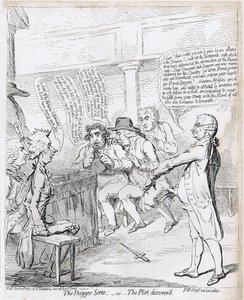The Dagger Scene, or the Plot Discover'd.
Only £185.00
Size 30cm x 37cm
Originally published by Hannah Humphrey etched by James Gillray from 'The Genuine Works of James Gillray, engraved by himself. Thomas McLean edition on heavy rag-paper from the original copper plates printed 1830.
Though altered and elaborated for political purposes, Gillray's The Dagger Scene, or the Plot Discover'd is based upon a real event that took place in the House of Commons a few days earlier on December 28th, 1792 during the debate over the Aliens Act. The act was a response to the huge influx of French emigres following the September Massacres in which thousands of Frenchmen were summarily executed for suspected Royalist sympathies.
Supporters of the new legislation like Burke, Pitt, and Dundas saw it as a way of keeping an eye on aliens entering the country under the guise of fleeing terror but in reality acting as agents to spread the infection of revolution to the shores of Britain. Opponents such as Fox and Sheridan saw it as unfair to immigrants who, in fact, were fleeing to England in desperation to escape persecution because they had opposed the politics and violence of the new regime. And the Whigs challenged the Tory government to provide concrete instances where French immigrants were responsible for criminal or seditious acts.
It was in this context that Burke delivered his impassioned, some might say stagily histrionic speech, in support of the bill, arguing that the additional restrictive measures proposed were necessary safeguards of British liberty, and that the threats from persons now in the country were both real and imminent.
As described in Cobbett's Parliamentary History, he then "mentioned the circumstance of three thousand daggers having been bespoke at Birmingham by an Englishman, of which seventy had been delivered. It was not ascertained how many of these were to be exported, and how many were intended for home consumption. [Here Mr. Burke drew out a dagger which he had kept concealed, and with much vehemence of action, threw it on the floor.]" Much of what appears in Burke's speech bubble is roughly transcribed from the actual speech in Parliament. But the reactions of both sides of the House are Gillray's creation.
At the time this print appeared, Burke was technically a Whig, but he had famously and publically parted company with Fox over the revolution in France, a scene memorialized in Gillray's The Impeachment, or The Father of the Gang Turn'd Kings Evidence (1791). And from being lumped with Fox and Sheridan as just another Whig in prints like Blood and Co. Setting Fire to the Tower & Stealing the Crown (1788) or as the primary butt of Gillray's anti-Catholic satire in Cincinnatus in Retirement (1782), Burke was now assuming a much more normative role and indeed the nemesis of Fox and Sheridan in The Impeachment. . . (1791) and Guy Vaux Discovered in his Attempt to Destroy the King & the House of Lords (1791).
It is striking that here in this print, Burke stands between the opposing benches, neither Whig nor Tory. And unlike the caricatured reactions of the guilty Whigs whose supposed plot Burke has uncovered or the terrified Tories fearing for their lives, Burke is scarcely caricatured at all. Instead he appears in an idealized pose that derives from the Apollo Belvedere and would have been seen by Gillray in Reynold's painting of Commodore Augustus Keppel.
But in borrowing a well-known and much used pose, Gillray may also be calling attention to the self-consciousness of Burke's carefully cultivated image as patriot and his studied use of the dagger for dramatic effect. As a playwright himself, Sheridan did not miss the theatricality of Burke's ploy, and after what must have been a pregnant moment of dramatic suspense, he is supposed to have replied. "You have shown us the knife, Where are the fork and spoon?" (www.james-gillray.org)
 View Account
View Account
